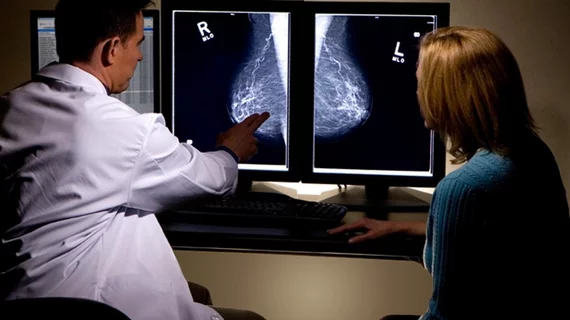DBT plus synthesized mammography drops patients’ dosage without losing imaging quality
Digital breast tomosynthesis paired with synthesized mammography offers more screening benefits for breast cancer patients compared to using digital mammography alone, according to a new meta-analysis published in European Radiology.
DBT plus DM has been shown to increase both sensitivity and specificity, but at the expense of an increased radiation dose for the patient. In an effort to avoid this increase, researchers tried substituting s2D with DBT images, and compared the results to conventional DBT plus DM. They hypothesized that calculating synthesized images from the DBT dataset could avoid a double exposure to the patient without sacrificing diagnostic quality.
“The combination of DBT plus s2D promised to maintain the diagnostic advantages of the new method at a radiation dose which is comparable to or only slightly higher than that of DM,” Sylvia H. Heywang-Köbrunner, with the National Reference Center Mammography in Munich, and co-authors wrote.
For the study, researchers foraged through PubMed papers published between January 1, 2010, and September 2, 2020, and eventually selected 12 papers involving 414,281 women. Only studies that compared DBT with s2D to using DM alone in breast cancer screening were included.
DBT paired with s2D increased both cancer detection rates and positive predictive values among patients, while recall rates saw a drop in frequency. Biopsies recommended and biopsies performed also both increased with the new method.
“DBT plus s2D is associated with higher CDR and concurrently with fewer recalls. Furthermore, higher cancer detection per 100 women with recommended or performed biopsy underlines that DBT plus s2D is more precise in identifying cancers than DM alone,” researchers stated.
You can read the detailed study in European Radiology.
Related Breast Imaging Technology Content:
3D mammography approaching 50% of breast imaging systems in the US
Ultrasound alone detects 92% of breast cancers recalled on DBT exams
Breast MRI screening cuts cancer mortality rates in half for women with lesser-known gene mutations
DBT spot compression views increase reader accuracy
Digital breast tomosynthesis outperforms DM at detecting malignancy in developing asymmetries
AI drops DBT workloads for radiologists by 40% while also reducing recalls
Less experienced radiologists are more susceptible to fatigue when reading DBT exams
Stand-alone AI can reduce radiologists’ screening mammography workloads by 90%
Imaging center has credentials revoked following ‘severe’ issues with mammography screening
Q&A: Should COVID vaccinated patients delay getting breast imaging — new study says no

